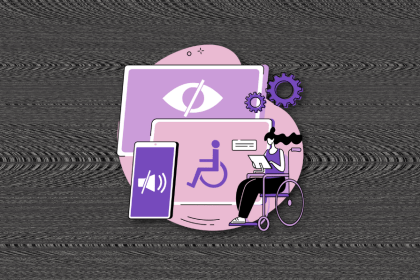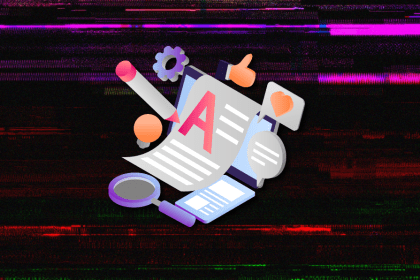Are you thinking of accessibility? There’s no better time to endorse, promote, and support the largest minority group in the world.

It’s time to conquer the preconceptions of accessibility, overcome the skepticism of accessible design, and undertake the process of creating websites and products that benefit everyone.
Suppose you’re a designer or in a similar/related domain. In that case, this article aims to equip and inspire you to advocate accessibility in the design process because there will always be a need, and the evidence is apparent.
The data is clear. WebAIM’s 2024 report analyzed 1,000,000 websites, and the most significant result was that “95.9 percent of home pages had detected WCAG 2 failures.” And to make matters worse, “These are only automatically detected errors that align with WCAG conformance failures with a high level of reliability, which suggests that the rate of full WCAG 2 A/AA conformance was certainly lower.”
However, the WebAIM report states, “Pages with fewer errors have gotten better while pages with many errors have gotten worse.” This statement suggests that those who know about accessibility and its requirements are increasing their standards, while those who don’t appear to keep falling behind.
Perhaps people are uninformed about the need for accessibility in design, or maybe a more realistic perspective could be that some people oppose the needs and requirements of accessibility.
The following sections examine and debunk five common points designers may face regarding the implementation and promotion of accessibility in their daily practice.
Without further delay, let’s begin.
There’s no denying this point of view: accessibility is costly. Yet, should the cost be paid from the beginning or once the design goes live?
In 2005, the National Federation of the Blind (NFB) discovered that the Target Corporation website was “Not accessible to blind and visually impaired users.” A lawsuit followed, and Target settled with the NFB under the Americans with Disabilities Act (ADA) for $6 million.
You might believe you’re safe excluding accessibility processes from your website outside the USA, but you’re wrong. There are laws and guidelines aimed at reducing ableism on the web almost everywhere, such as WCAG (Global), AODA (Canada), EU Web Accessibility Directive (Europe), and Australian DDA (Australia), and the list continues:
To reaffirm the data and reinforce the prospect of legal action if and when a website lacks accessibility, the UsableNet 2023 Midyear Report on Digital Accessibility Lawsuits found an increase from 2314 in 2018 to an estimated 4220 in 2023 digital accessibility lawsuits. That’s over a 45 percent increase within five years. What about 2022 to 2023? The number of lawsuits increased by more than 4.3 percent over a year, confirming the requirement and promotion for accessibility on the web.
On the other hand, if accessibility practices are conducted from the beginning of the design process and considered a fundamental part of the approach, then the valuation is absorbed into the product itself. This is a better approach instead of using all the needed resources to create the product and then either backtracking to include accessibility or, worse, being taken to court.
Unsurprisingly, the data reinforces this assumption and indicates a potentially untapped user group.
The United Nations Educational, Scientific and Cultural Organization (UNESCO) estimates that “765 million youth and adults worldwide still lack basic literacy and numeracy skills.” The Centers for Disease Control and Prevention (CDC) states that “1 in 4,” or 27 percent of “adults in the United States have some type of disability:”
Then, looking at the rest of the globe concerning the umbrella term disability, the World Health Organisation (WHO) estimates that “1.3 billion people experience significant disability. This represents 16 percent of the world’s population, or 1 in 6 of us.”
In a time when profit is the priority, and the users are designed for, forgetting the marginalized and underrepresented groups begins to celebrate uniformity rather than diversity. Acknowledging that a large proportion of the population is less able and equals the largest minority group is the first step.
The amount of people who are differently abled is evident, but what about the different kinds of disabilities?
The World Wide Web Consortium (W3C) and Web Accessibility Initiative (WAI), two collaborative organizations that established and maintain the WCAG and develop web standards, categorize disabilities to design for into:
The list can seem daunting. Thankfully, the W3C has formulated accessibility standards called Web Content Accessibility Guidelines (WCAG 2.2). They declare, “Following these guidelines will make content more accessible to a wider range of people with disabilities.” Then, continue, “but will not address every user need for people with these disabilities.” Many variables exist depending on the situation, the user’s capabilities, and the task/s at hand.
How do we overcome these hurdles? The answer is to recognise when to use which approach and to keep testing. Furthermore, utilizing WCAGs will assist in designing for the above six disability categories and decrease the overwhelming myth that there are too many disabilities to design for.
Flashy, innovative features don’t translate into accessibility but do translate into profit, an assumption passed on through the digital sphere—a narrow one that has been proven wrong time after time.
Focusing on accessibility has translated into innovations and brand growth. Innovative designs used by differently abled and able people include subtitles/closed captioning, voice assistance, automatic doors, touch screens, and so on:
Apple’s accessibility website and products provide notable examples of technology used by both able and disabled people.
Additionally, Legal & General Group successfully adapted its website for accessibility. After conducting UX research into its website accessibility, it concluded that a redesign was necessary. Once the new website went live, the data spoke for itself. A few key results from the website update were a 50 percent increase in natural search engine traffic, a 66 percent cost reduction in maintenance, and a 100 percent return on investment in 12 months.
To be unaware of your website accessibility downfalls and to fall into the trap of expecting to be told about the failures is detrimental to your business:
To once again quote the Click-Away Pound 2016 survey, “71 percent of disabled customers with access needs will click away from a website that they find difficult to use.” The survey also found, “Most businesses will be unaware that they are losing income because more than 90 percent of customers who have difficulty using a site will not contact them.” To operate in ignorance of your website or product accessibility issues is the same as deliberately sabotaging the business.
Now, let’s consider the proactive stance on balancing what you can control and understanding what you can’t control. You’ve guessed it! Resources are abundant online that can guide you in designing an accessible website or product.
If you require assistance from an outsider’s perspective, many organizations and individuals focus on and understand accessibility for the web. Conducting your research to find suitable resources for your website/product/process accessibility is central if you want to see the benefits of including accessibility.
Imagine spending weeks, months, if not years, working on the design of a website or product and finally reaching the go-live date. Not long after, you receive that dreaded communication and discover your design is fundamentally flawed with little to no accessibility. As a result, the consequences are detrimental to the design, your career and self-esteem. Alternatively, a strategic approach toward accessibility could’ve resulted in continual business and personal growth.
The assumptions that reject and negate accessibility implications for our websites and products are built on truth, yet fall short of representing the facts.
Incorporating accessibility practices can be financially beneficial in the long run, as it reduces the possibility of being sued for not including accessibility in the design, which can harm your brand’s reputation.
There are indeed more able users than lesser able users. However, they are the largest minority group in the world, and they happen to require accessible design. Forgetting this detail could result in diminishing and missed returns.
LogRocket's Galileo AI watches sessions and understands user feedback for you, automating the most time-intensive parts of your job and giving you more time to focus on great design.
See how design choices, interactions, and issues affect your users — get a demo of LogRocket today.

I’ve spent enough time designing with WCAG 2.2 to know it’s not enough. Here’s why I’m skeptical and cautiously hopeful about WCAG 3.0.

I learned this lesson the hard way. Good UX doesn’t survive endless approval loops. Here’s what went wrong — and how to protect your vision.

I’ve reviewed “final” designs more times than I can count — and the copy almost always gives users a reason to hesitate.

The checkbox is one of the most common elements in UX design. Learn all about the feature, its states, and the types of selection.